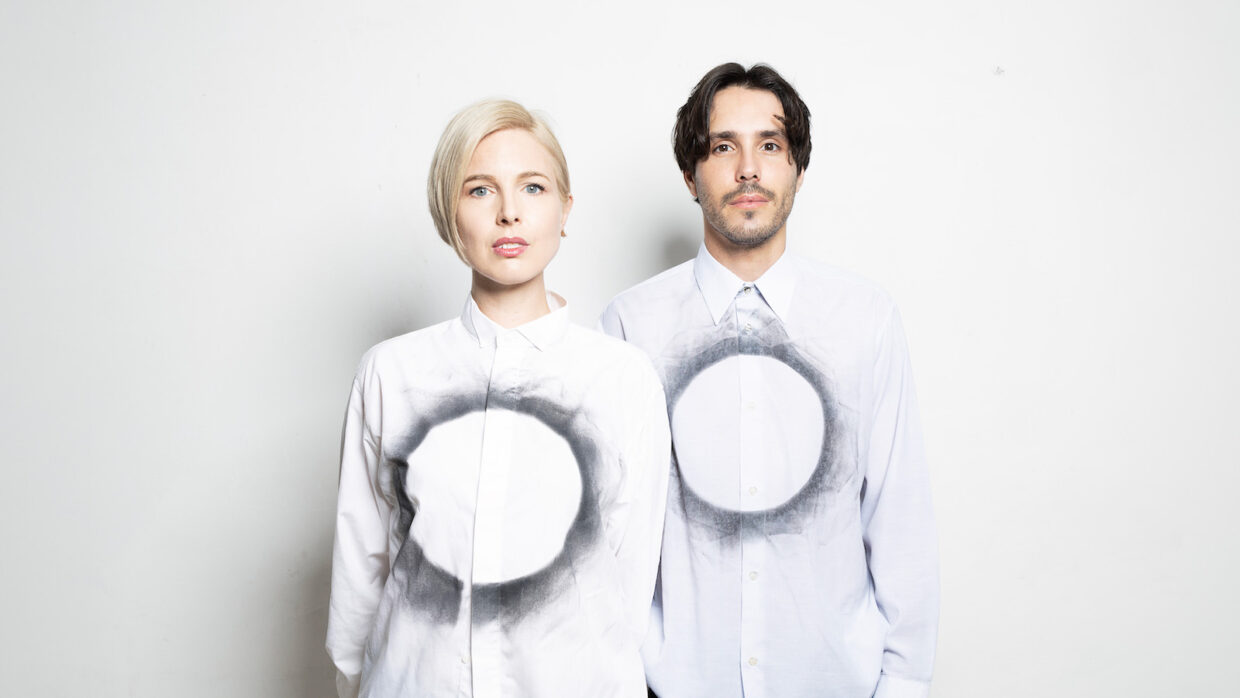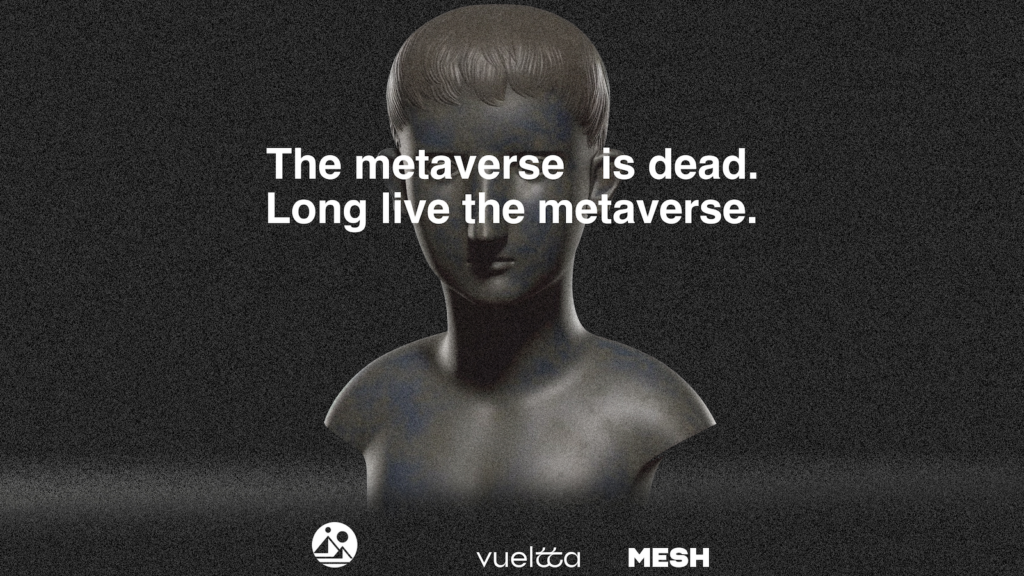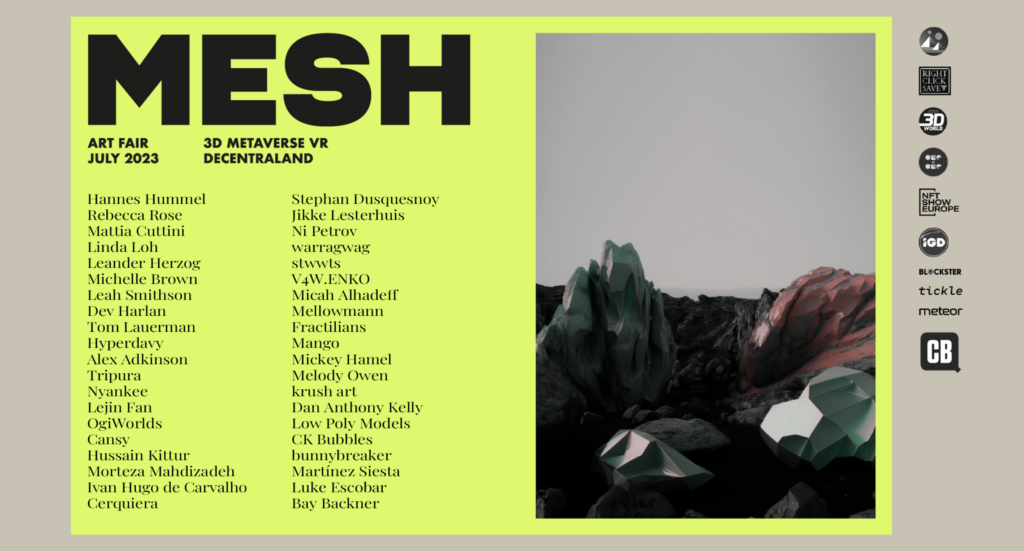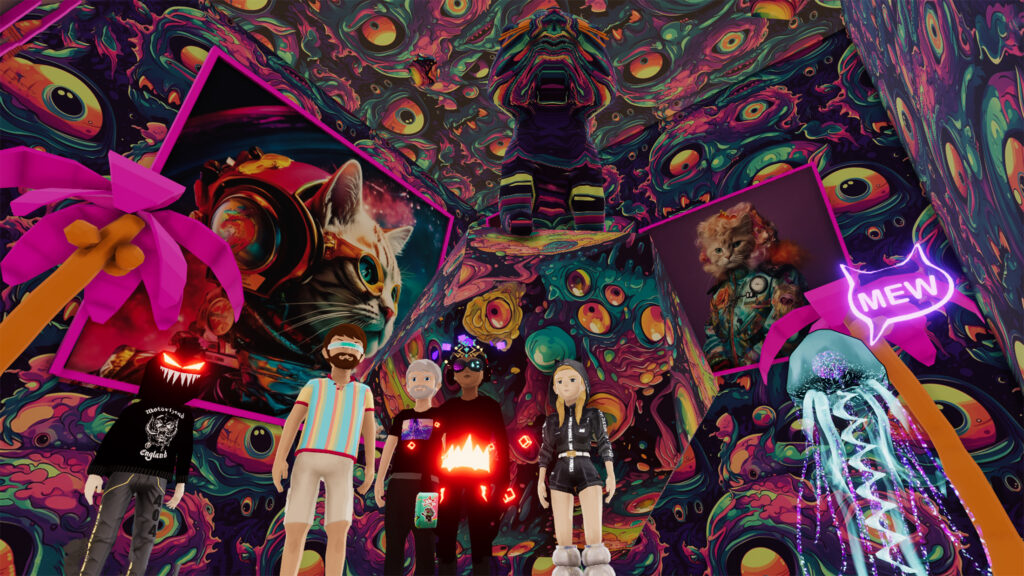Pioneering Web3 producer and artist Bay Backner is making waves in the digital art world with an innovative blend of metaverse installations, immersive technologies, and traditional oil painting. The founder and director of MESH, an art fair dedicated to creators in the realms of 3D, metaverse, and virtual reality, Backner is also the co-founder of Vueltta, an international art collective known for producing immersive installations in the Decentraland metaverse.
In addition to her leadership roles at Mesh and Vueltta, Backner is the curator of this month’s Metaverse Art Week 2023, and as an artist, boasts a portfolio that spans a variety of mediums and platforms. Backner’s recent work includes “The Muse Headdress” (2022) and “Muses 2 Metaverse Performance” (2022), which underscore her unique ability to merge the time-honored art form of oil painting with the latest technologies, resulting in a distinctive style that pushes the boundaries of digital art.
JCC recently caught up with Bay Backner to discuss her role as the curator of Metaverse Art Week 2023, the challenges and opportunities of curating in the metaverse, and the importance of shared digital experiences in the future of art.
As the curator of Metaverse Art Week 2023, what are the key themes or trends you aim to highlight during the event?
I chose “The metaverse is dead. Long live the metaverse” as the theme for Metaverse Art Week this year. The “metaverse” as a term is in such a period of transition and evolution, that what excited me the most was to highlight the artists and creators who, despite everything, are continuing to make great work. It seems almost transgressive to unashamedly use the word ‘metaverse’ right now. And as an artist, I like that. It’s the catalyst for riskier new work and collaborations.
Being asked, “Wouldn’t it be better to call it something else?” only made me and the members of Vueltta, the arts collective I work as part of, more committed to bringing this together. We joke that this was the year that the metaverse went punk.
So we turned Metaverse Art Week 2023 into a week-long, no-holds-barred art party for those of us quietly building the ‘real’ virtual world… and the people who see the creative value in being in early on this work.
Our main event is MESH, the art fair for 3D, metaverse and VR creators. Around this, we’ve planned installations with underground, yet thriving, virtual creative communities, including VERTEX by GucciToe x Tangpoko, HERE & NOW by Michael Beets.
We finish every day of Metaverse Art Week 2023 with a party. Not only to celebrate but because we see metaverse parties and their wearable culture (digital clothes which change during the events), as an emerging expressive art form. We wanted to open this nascent movement to the wider art world – sharing our passion for the digital party creators who innovate at every event.
Can you tell us more about MESH? What can attendees expect from this event?
MESH is the art fair for 3D, metaverse and VR creators. The intention is to connect the world’s leading 3D artists with galleries, creative studios and collectors – those future-focused people who understand the growing importance of this space.
We gained the support of some inspiring names early on in the development of MESH, who went on to become our curation board. These include Kate Vass of Kate Vass Galerie; Edward Zipco of SuperChief NFT, Lynn Rosenberger of The NFT Gallery, London, and collectors Anesti Dhima, OMZ and Belle NFTs.
Alex Estorick, editor-in-chief at Right Click Save and contributing editor at Flash Art, has been instrumental as both a curator and a sounding board for the event.
At MESH, attendees can explore over thirty floating ‘white cubes.’ Inside each cube, they’ll experience an immersive installation created specifically for MESH by over thirty international artists. These include Hannes Hummel, Rebecca Rose, Mattia Cuttini, Linda Loh, Michelle Brown and Leah Smithson.
The MESH cubes are set in an immersive environment that we, Vueltta, designed in collaboration with architect Luke Escobar. This is based on the work of Ike Taiga, a Japanese Edo-period painter and printmaker born 300 years ago this year. Visitors will see Taiga’s work reflected in the topology of the environment, and the enormous screens featuring projections of animations created by the AI model we trained on his work.
Attendees should expect that every MESH cube is a self-contained experience. Each artist had entirely free rein on what they chose to present and how. It’s made for a complex and many-layered show, almost as though you’re entering into the current artistic preoccupations of each artist – made real in a 3D environment.
How does the selection process work for venues, districts, and organizations that want to be part of the official Metaverse Art Week program? What criteria do you use to evaluate applicants?
We put the call for work out within existing metaverse communities. It was important for us to reflect the artists working in the space, rather than commercial entities or brands. It meant that organizers and venues heard about us through word of mouth, Twitter Spaces or Discord channels.
The criteria were about digital community and online art culture. Specifically, whether a venue already supported a virtual creative community, or whether it reflected something from the cultural history of current immersive creators. So we have installations by HERE & NOW, a group of artists who “take culture seriously; we are curious about what virtual experiences can do,” alongside exhibitions by UXArt, a team who have worked with IBM to reconstruct some of the earliest generative art pieces. We’re proud to include niche installations like DecentraPEPE Shrine by architect Rizk Ghazaly, one of the earliest metaverse builds minted in 2017.
We also scouted for iconic metaverse venues with which we could collaborate to hang art. So we’ve worked with established metaverse builder Mr. Dhingia to hang art by Florencia Bruck, Miss A Simpson, Mueo, Enrique Agudo and Rukmunal Hakim in a floating mythological Vimana, and we’ve placed works by twenty international NFT artists in the ELO Chess Club, a Decentraland institution.
Metaverse is a close-knit culture right now, so we reached out to our favorite party organizers to ask if they would like to be on the program. All said yes and are creating new installations and themed events.
How do you envision the role of immersive experiences in the future of art, based on your work with Metaverse Art Week and Vueltta?
Shared digital experiences have as much cultural significance as IRL (in real life) events for a growing number of people. We see this in the importance upcoming generations place on world-building with others and shared events on platforms such as Fortnite. These experiences both define us as individuals and create genuine connections with others.
I’m vehemently not a gamer, so came to metaverse with a deep skepticism about what was possible for art. This quickly changed as I came to see metaverse as space. So much of my own practice as a curator and artist had been preoccupied [with] space – finding it, affording it, and using it to share meaningful experiences with others. Here was an infinite space, with practically infinite possibilities, in which I and others could create immersive experiences and share them with anyone in the world. A new media form that allows us to “hack” geographies and spatial constraints.
That to me and the artists I work with is enormously exciting. Behind closed doors, many of us talk of this as a new art movement. It gives us that much energy to create.
Can you share some of the challenges and opportunities you’ve encountered while curating an art event in the metaverse, as opposed to a traditional physical setting?
This is a huge question. Metaverse is an entirely new media so there are few social cues about how events ‘should’ be. For example, in theatre we know when a performance starts when the curtains open, that we should be quiet in a cinema or art gallery, that we don’t touch the artworks. Metaverse has none of these cues. So managing metaverse art events can be gloriously chaotic and everything that ‘shouldn’t’ happen, does.
Avatars interact with installations in ways that you could never have imagined, and start times across the whole of the world’s time zones are always going to be hard to enforce. This opens considerations around each individual’s journey through an installation – wayfinding; whether a guiding voice or soundscape can add to the sense of progression or closure; what ‘experiencing’ the event in its entirety actually means.
Communication of information is also different. We want to respect each artist by showing their texts, but textual content can quickly become overwhelming in a metaverse space. So we play with hyperlinking objects, downloadable guides or spoken word.
Of course, gaming culture permeates metaverse, and this is something we’re beginning to explore as both artists and curators. What richer levels of immersive experience are possible if we apply tropes from games? To what extent can shared ‘quests’ be part of an art happening or event? We’re just at the beginning of this story.






